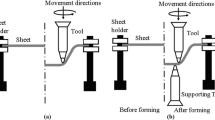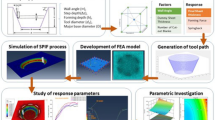Abstract
Single point incremental sheet forming stands out mainly by using traditional CNC machines to produce small batches of parts or customized products. Thus, any excessive force in the process may compromise the integrity of the machining center or even damage the component itself, limiting its formability. Hence, this work presents the design of experiments to investigate the behavior of mechanical forming forces and optimize the process. The main goal was to build a mathematical function by regression analysis that best represents the theoretical model. The equation proposed here allows to locate and estimate the maximum effort Fz_peak based on five input parameters: tool diameter; wall angle; sheet thickness; vertical step size; and tool feed rate. At the same time, determine the set of data that maximize the required formability. The test was carried out using a carbide coated tool K40 and a commercial sheet steel ASTM A653 CS-A G90. The following were found: the feed rate is not significant and can be maximized to reduce production time; the tool diameter and wall angle are significant, and they have a slight influence on the forces and both depends on the design area; the vertical step size is significant and the most important parameter to leveling the process to reach maximum formability. Finally, the sheet thickness is obviously significant; however, it is also specified by the design.










Similar content being viewed by others
References
Ying S (2003) Fundamental studies on the incremental sheet forming of titanium. Bachelor Individual Project, Faculty of Engineering, University of Nottingham, Nottingham
Schaeffer L (2004) Conformação Mecânica. Editora Imprensa Livre, p 167
Emmens WC, Sebastiani G, van den Boogaard AH (2010) The technology of incremental sheet forming—a brief review of the history. J Mater Process Technol 210:981–997. https://doi.org/10.1016/j.jmatprotec.2010.02.014
Schwab K (2016) The fourth industrial revolution, 1st edn. World Economic Forum, Switzerland, p 198
Mugendiran V, Gnanavelbabu A, Ramadoss R (2014) Parameter optimization for surface roughness and wall thickness on AA5052 aluminium alloy by incremental forming using response surface methodology. Proc Eng 97:1991–2000. https://doi.org/10.1016/j.proeng.2014.12.442
Jeswiet J, Young D (2005) Forming limit diagrams for single-point incremental forming of aluminium sheet. Proc IMechE Part B J Eng Manuf 219:359–364. https://doi.org/10.1243/095440505X32210
Mohammad JM, Bijan MD (2012) Analysis of incremental sheet metal forming using the upper-bound approach. Proc IMechE Part B J Eng Manuf 226:1309–1320. https://doi.org/10.1177/0954405412445113
Aerens R, Eyckens P, Van Bael A et al (2010) Force prediction for single point incremental forming deduced from experimental and FEM observations. Int J Adv Mfg Technol 46:969–982. https://doi.org/10.1007/s00170-009-2160-2
Henrard C, Bouffioux C, Eyckens P et al (2011) Forming forces in single point incremental forming: prediction by finite element simulations, validation and sensitivity. Comput Mech 47:573–590. https://doi.org/10.1007/s00466-010-0563-4
Jeswiet J, Micari F, Hirt G et al (2005) Asymmetric single point incremental forming of sheet metal. Ann CIRP 54:88–114
Ambrogio G, Filice L, Micari F (2006) A force measuring based strategy for failure prevention in incremental forming. J Mater Process Technol 177:413–416. https://doi.org/10.1016/j.jmatprotec.2006.04.076
Duflou J, Tunçkol Y, Szekeres A et al (2007) Experimental study on force measurements for single point incremental forming. J Mater Process Technol 189:65–72. https://doi.org/10.1016/j.jmatprotec.2007.01.005
Ingarao G, Ambrogio G, Gagliardi F et al (2012) A sustainability point of view on sheet metal forming operations: material wasting and energy consumption in incremental forming and stamping processes. J Clean Prod 29–30:255–268. https://doi.org/10.1016/j.jclepro.2012.01.012
Ambrogio G, Duflou J, Filice L et al (2007) Some considerations on force trends in incremental forming of different materials. AIP Conf Proc 907:193–198
Petek A, Kuzman K, Kopac J (2009) Deformations and forces analysis of single point incremental sheet metal forming. Arch Mater Sci Eng 35:107–116
Bagudanch I, Garcia-Romeu ML, Centeno G et al (2015) Forming force and temperature effects on single point incremental forming of polyvinylchloride. J Mater Process Technol 219:221–229. https://doi.org/10.1016/j.jmatprotec.2014.12.004
Babu SC, Kumar VSS (2012) Experimental studies on incremental forming of stainless steel AISI 304 sheets. Proc IMechE Part B J Eng Manuf 226(7):1224–1229. https://doi.org/10.1177/0954405412441286
Li Y, Liu Z, Lu H et al (2014) Efficient force prediction for incremental sheet forming and experimental validation. Int J Adv Mfg Technol 73:571–587. https://doi.org/10.1007/s00170-014-5665-2
Ambrogio G, Filice L, Gagliardi F (2012) Formability of lightweight alloys by hot incremental sheet forming. Mater Des 34:501–508. https://doi.org/10.1016/j.matdes.2011.08.024
Tiburi F (2007) Aspectos do processo de estampagem incremental. Escola de Engenharia, Universidade Federal do Rio Grande do Sul, BR, Dissertação de Mestrado
Acknowledgements
The authors would like to acknowledge financial support from the Federal University of Parana (UFPR), CNPq and FECIAL Industry for supplying the tools and the rig so that this research could be carried out.
Author information
Authors and Affiliations
Corresponding author
Ethics declarations
Conflict of interest
The authors declare that there is no conflict of interest.
Additional information
Technical Editor: Márcio Bacci da Silva.
Rights and permissions
About this article
Cite this article
Valle, P.D., Amorim, F.L., Da Costa, D.D. et al. Experimental investigations on the incremental sheet forming of commercial steel ASTM A653 CS-A G90 to predict maximum bending effort. J Braz. Soc. Mech. Sci. Eng. 40, 322 (2018). https://doi.org/10.1007/s40430-018-1251-0
Received:
Accepted:
Published:
DOI: https://doi.org/10.1007/s40430-018-1251-0




